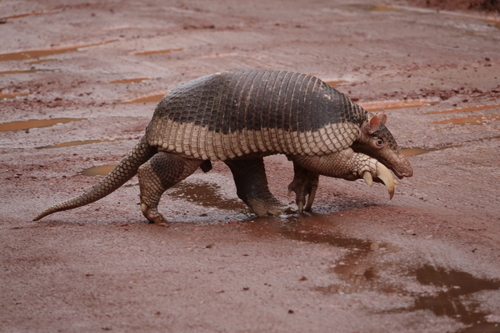
Giant Armadillo
The giant armadillo, or Priodontes maximus, boasts an impressive armored shell and formidable claws, essential for its termite diet. This nocturnal giant, residing in South American forests and savannas, is a vital soil aerator, fostering ecological health through its burrowing and feeding habits.
12-15 years
Lifespan
18.68 - 32.27 kg
Weight
Length: 83 - 96 cm
Size
Grey, Black
Color
9-12 months
Age of Sexual Maturity
6 months
Age of Weaning
30 mph
Top Speed
Vulnerable
Conservation Status
Decreasing
Population Trend
Characteristics
Priodontes maximus, commonly known as the giant armadillo, is the largest species of armadillo. It inhabits tropical forests, grasslands, and savannas across South America. Notable for its large, protective shell and long claws, it primarily feeds on ants and termites. Its nocturnal nature and burrowing behavior play a significant role in soil aeration and ecosystem balance.
Distribution Range of the Giant Armadillo
Priodontes maximus, commonly known as the giant armadillo, is native to South America. Its geographical distribution includes countries such as Venezuela, Colombia, Ecuador, Guyana, Suriname, French Guiana, Brazil, Bolivia, Paraguay, and Argentina. The species is primarily found east of the Andes Mountains.
Giant Armadillo's Habitat
Environmental Conditions
The giant armadillo inhabits a variety of forested environments, including tropical rainforests, deciduous forests, and savannas. It prefers undisturbed primary forests but can also be found in secondary forests and open savannahs. The climate in these regions is typically warm and humid, with significant rainfall, although it can also adapt to drier areas.
Ecological Niche
As a nocturnal and solitary species, the giant armadillo plays a vital ecological role as a burrower, impacting soil structure and creating habitats for other species. It primarily feeds on ants and termites, which positions it as a crucial part of the ecosystem for controlling insect populations. Its adaptations include strong claws for digging and a protective shell for defense against predators.
Copyright @ Nature Style Limited. All Rights Reserved.
 English
English